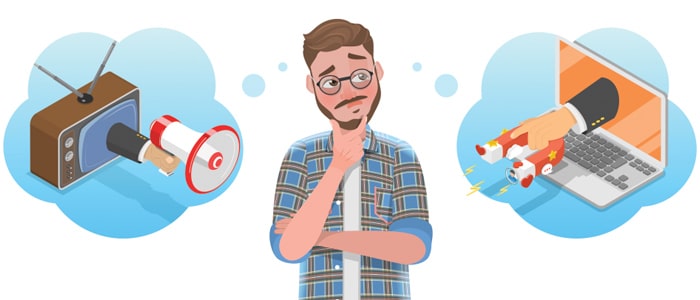
Is It Really David vs Goliath?
So much of 21st-century life takes place online with social interaction, shopping, education, community, etc. But that doesn’t mean print and local advertising are dead!
What are the benefits of each marketing method, and which should you choose for your business?

Digital Marketing
Digital marketing is the use of digital or online avenues as tools for your marketing strategies. This includes methods such as websites, social media, pay-per-click ads, affiliate links, sales funnels, webinars, and even email.
If you’ve ever scrolled Facebook or Instagram, you’ve probably seen the “Click to Learn More” or “Buy Now” buttons in your feed. Or when you head over to read the latest installment of your favorite blog, they may have pay-per-click or affiliate ads sprinkled throughout the page. Those are all examples of digital marketing.
There’s no denying that digital marketing has become increasingly popular due to the technological and cultural shifts of our modern-day, internet-addicted generation. HubSpot’s research reported that half of the revenue for businesses is influenced by social selling.
Meaning digital marketing is becoming the primary revenue driver for most businesses across the board.
What’s Great About Digital Marketing?
Simply stated, the possibilities are endless.
Due to the ability to test and redistribute funds, digital marketing budgets can be more flexible. This also means you have far more control over your audience growth and can measure results in real-time.
You’re not out there knocking on their virtual doors, the consumers come to you. This is what is known as ‘pull’ advertising or inbound marketing. You show up when the viewer is searching for specific information, products, or services on their phone or laptop.
Remember life before the internet? Gen Z doesn’t. They consider radio for dinosaurs and pay little attention to printed resources. If your audience is young and hip (or whatever they say these days) then you won’t reach them at all without taking advantage of a solid digital marketing strategy.
Digital marketing is happening NOW. The ad is in front of the consumer and the button for taking action is right in front of them. This compels a real-time reaction. They can engage, buy, contact, schedule, learn, shop, register, or subscribe immediately.
A few cautions before diving, neck deep, into digital marketing exclusively:
- Online ads can be annoying. The internet is pretty saturated as every Tom, Dick, and Harry is looking to “get theirs”. Take care to create your ads with the consumer in mind to make the experience less annoying.
- Digital is fleeting. They scroll, they see, they keep scrolling. The time-tested “marketing rule of 7” says that’s how many times it may take for your customer to see your ad before they take action.
- Internet security and social media policies are a revolving door of change. It can be overwhelming to constantly adapt your marketing strategies to suit Zuckerberg’s latest requirements.

Traditional Marketing
Traditional marketing deploys across more traditional channels, like billboards and printed media. The “Mad Men” adjacent channels, if you will. It was the institution of all marketing until its competition was developed in the 1990s.
Traditional marketing encompasses any type of marketing that isn’t on the world wide web. Phone, print, broadcast, direct mail and outdoor surface ads are all methods of traditional marketing.
It’s what’s known as “push” marketing, the opposite of “pull”, as with digital. You’re reaching out to audiences with your message. Your ad is in their paper, delivered right to their front door. Your billboard is on the bench where they rest at the park. Your ad is in the phone book (Yep! They still give those away!). Your ad is on that flyer they were handed directly at an event.
While traditional marketing is pushing your message out to a wide audience, it isn’t a precisely targeted audience. This means there’s no immediate engagement with your consumer and your metrics to measure response rates will be inconsistent.
What’s Great About Traditional Marketing?
Print ads are a physical representation of a service or experience. They’re kept around, stuck to fridges, and stuffed into wallets. These tangible pitches increase brand recognition and can lend a certain level of credibility.
Traditional marketing methods work better for a more mature audience. If you’re marketing to senior citizens (or anyone who DOES remember life before the internet), the level of trust they’ll have in a print ad is significantly higher than in a digital one.
A physical print ad carries a greater impact than that of a digital ad and lasts longer than the three-second scroll. They’re memorable! The Guardian conducted a study of Kindle readers and found that they scored lower in story recall than those who’ve read the same material in its physical format.
Marketing to a geographical audience is well served by traditional methods. You want them to see you in the mail, the store, the paper, AND on their phone or laptop.
What Works For You?
It’s not a question of either/or. It’s a matter of developing a strategic balance between the two marketing methods.
How can you use elements of both effectively?
It’s possible, and necessary, to deploy a harmonious strategy that incorporates the best of both worlds. It all depends on what your customer wants. And if you know your target market, you should know where to find them and how they will want to find you.




